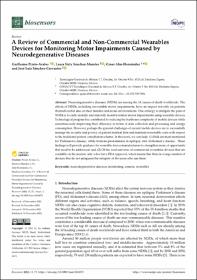A Review of Commercial and Non-Commercial Wearables Devices for Monitoring Motor Impairments Caused by Neurodegenerative Diseases
Fecha
2022-12-31Autor
Prieto-Avalos, Guillermo
Sánchez-Morales, Laura Nely
Alor-Hernández, Giner
Sánchez-Cervantes, José Luis
Metadatos
Mostrar el registro completo del ítemResumen
Neurodegenerative diseases (NDDs) are among the 10 causes of death worldwide. The effects of NDDs, including irreversible motor impairments, have an impact not only on patients themselves but also on their families and social environments. One strategy to mitigate the pain of NDDs is to early identify and remotely monitor related motor impairments using wearable devices.
Technological progress has contributed to reducing the hardware complexity of mobile devices while simultaneously improving their efficiency in terms of data collection and processing and energy consumption. However, perhaps the greatest challenges of current mobile devices are to successfully manage the security and privacy of patient medical data and maintain reasonable costs with respect to the traditional patient consultation scheme. In this work, we conclude: (1) Falls are most monitored
for Parkinson’s disease, while tremors predominate in epilepsy and Alzheimer’s disease. These findings will provide guidance for wearable device manufacturers to strengthen areas of opportunity that need to be addressed, and (2) Of the total universe of commercial wearables devices that are available on the market, only a few have FDA approval, which means that there is a large number of devices that do not safeguard the integrity of the users who use them.
Temas
neurodegenerative diseasesmonitoring
sensors
wearables
Tipo
ArticleColecciones
- Artículos (DCI) [72]



